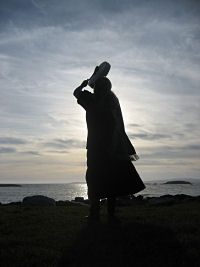What is the basis of your spiritual practice?
 Traveller's Joy was founded on the shamanic perspective that healing the
soul restores our sense of wholeness and our sense of this planet as our
home. As a result, we become more conscious of our relationships with other
beings and the planet; our soul healing contributes to the greater good.
While Traveller's Joy promotes shamanic techniques, we honour the many ways
that people seek healing and connection to the Creator.
Traveller's Joy was founded on the shamanic perspective that healing the
soul restores our sense of wholeness and our sense of this planet as our
home. As a result, we become more conscious of our relationships with other
beings and the planet; our soul healing contributes to the greater good.
While Traveller's Joy promotes shamanic techniques, we honour the many ways
that people seek healing and connection to the Creator.
What is shamanism?
The word shamanism covers a broad range of practices that have in common a belief that our material reality is just part of the whole picture, and that interacting with unseen realities can cause healing (or suffering). We are contemporary shamans, and we practice shamanism for the intention of healing.
What is the difference between traditional and contemporary shamanism?
Traditional shamanism sees the practice passed from one living teacher to another, with a training period that results in an initiation. Examples would be the shamanism practiced by small numbers of African, Australian, Brazilian or North American aborigines.
Contemporary shamanism is not restricted by tradition. The student may receive teachings from spirit guides and/or from a variety of living teachers before or after an initiation, which may be formal or spontaneous and spirit-led. When seeking a shaman for healing, it is a good idea to establish that they work from a place of high consciousness and awareness and that they have the experience and training to handle whatever may come up during a healing.
What defines a shaman?
 Traditionally, a shaman is a person who has an extraordinary ability to
interact with other realities, often referred to as the spirit world. Historically,
shamans go back to at least the neolithic period and it has been traditional
for people around the world to consult shamans for healing or otherwise have
them act as "go betweens" on their behalf. Traditional shamans
usually go through a period of study or training with living teachers and
undergo an initiation before becoming shamans themselves.
Traditionally, a shaman is a person who has an extraordinary ability to
interact with other realities, often referred to as the spirit world. Historically,
shamans go back to at least the neolithic period and it has been traditional
for people around the world to consult shamans for healing or otherwise have
them act as "go betweens" on their behalf. Traditional shamans
usually go through a period of study or training with living teachers and
undergo an initiation before becoming shamans themselves.
When you say that you use “shamanic tools” to help participants, what do you mean?
Group ritual, journaling, movement, prayer, sounding, visualizations and shamanic journeying techniques are typically included in a Traveller's Joy tour. Within the structure of a TJ trip, space is created for spontaneous activity. TJ guides emphasize the value of practicing shamanism within a strong container of connection to guidance and intuition. For more information about shamanism or shamanic techniqes, read through the FAQ section. Contact us directly with specific questions at:
What is shamanic journeying?
A shamanic journey is a method of problem solving. The person journeying is usually helped by a drum or focus instrument to access other realms, where they can find their own guides and retrieve their solution. Experienced shamanic guides help the person journeying find his/her way there and make sure that they find their way back to ordinary reality. Shamanic journeying should only be undertaken with an experienced practitioner, within a spiritual container.
What is a spiritual container?
A spiritual container is protective device (often referred to as a circle) that calls in the assistance of the helping spirits and helps define the intention of the activity. Containers often refer to the four cardinal directions as well as Heaven and Earth and are used in many cultures and spiritual practices.
What if I’m on a tour and I don't want to participate in an activity or visit a site?
The short answer is to do it anyway and see what happens. Often our reluctance and discomfort are our greatest teachers and pushing our personal envelopes can shower us with unexpected gifts. Also, since we choose every site intentionally with purpose, you'll want to get the most for your money and go along. Having said that, it is imperative that participants trust the intention and judgement of their guides. It would be unwise to book a tour knowing you have issues with an integral component. If you have questions about comfort levels, requirements or choice in activities we encourage you to contact us directly at: .
How do you choose your sites and itinerary?
Nancy Sherwood chooses the sites and plans the itinerary based on pilot
trips, intuitive guidance, history and the nature of the land. Different
sites lend themselves to different activities and experiences, from joyous
dancing to silent prayer, group ritual to contemplation and rest. There are
awesome views, comforting atmospheres, nourishing food and people needs to
be brought into the balance, as well as time contraints and physical limitations.
The intention is always to design a tour that will allow participants to
carry out their personal intention within the group experience in a safe
and fulfilling manner. Nancy occasionally makes herself available to clients
requesting a tour designed to suit their
inspiration. To ask about this service,
contact Nancy at:
.
© Nancy Sherwood. Web design and consultation by holmpage.com